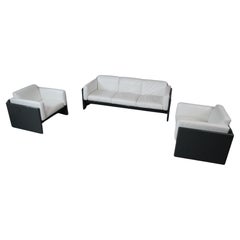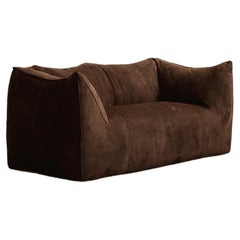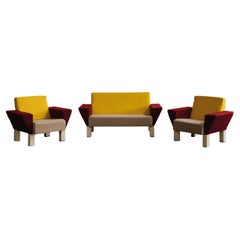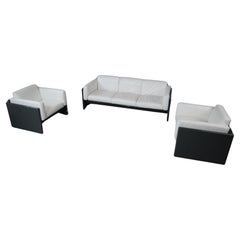Simon International Living Room Sets
to
1
1
Height
to
Width
to
Depth
to
1
1
1
1
1
1
1
1
1
1
1
1
1
9
54
52
42
42
Creator: Simon International
Arnolfo sofa set by Mauro Marzocchi for Simon International, 1971 Italy
By Simon International
Located in Langemark-Poelkapelle, BE
"Arnolfo" sofa set by Mauro Marzocchi for Simon International, 1971 Italy.
Grey lacquered high gloss wooden frame and original upholstery in stunning w...
Category
Late 20th Century Italian Mid-Century Modern Simon International Living Room Sets
Materials
Leather, Wood, Lacquer
Related Items
Mario Bellini "Le Bambole" Sofa for B&B Italia, Dark Brown Suede, 1971
By B&B Italia, Mario Bellini
Located in Lonigo, Veneto
Mario Bellini “Le Bambole” sofa for B&B Italia, dark brown suede, Italy, 1971.
This is a timeless Postmodern design icon. The starting point was a shopping bag containing formless m...
Category
1970s Italian Mid-Century Modern Vintage Simon International Living Room Sets
Materials
Foam, Suede
$11,550
H 28.75 in W 68.12 in D 34.65 in
Ettore Sottsass “Westside” Living Room Set for Knoll International, 1982
By Ettore Sottsass, Knoll
Located in Lonigo, Veneto
Ettore Sottsass “Westside” Living Room Set for Knoll International, foam and fabric, Italy, 1982, set of three.
The “Westside” collection is an icon...
Category
1980s Italian Mid-Century Modern Vintage Simon International Living Room Sets
Materials
Fabric, Foam
$18,700 / set
H 30.91 in W 61.62 in D 27.56 in
Mario Bellini "Le Bambole" Sofa for B&B Italia, Black Lapin Fur, 1971
By Mario Bellini, B&B Italia
Located in Lonigo, Veneto
Mario Bellini “Le Bambole” sofa for B&B Italia, black lapin fur, Italy, 1971.
This timeless Postmodern design icon came into being between 1970 and 1972. The search for a new shape ...
Category
1970s Italian Mid-Century Modern Vintage Simon International Living Room Sets
Materials
Foam, Fur
$15,000
H 29.53 in W 63 in D 33.47 in
“Down” sofa set by Carlo Bartoli for Rossi di Albizzate, 1970s Italy.
By Carlo Bartoli, Rossi di Albizzate
Located in Landgraaf, NL
“Down” sofa set by Carlo Bartoli for Rossi di Albizzate, 1970s Italy. Part of the Down series this set consists of one 3-seater, one 2-seater and a coffee table. Satin black lacquere...
Category
1970s Italian Mid-Century Modern Vintage Simon International Living Room Sets
Materials
Mohair, Wood
$21,817 / set
H 29.53 in W 84.26 in D 28.75 in
Saratoga Sofa by Vignelli for Poltronova, Italy, 1964
By Poltronova, Massimo and Lella Vignelli
Located in Antwerp, BE
'Saratoga' three-seat sofa by Italian designers Massimo and Lella Vignelli for Poltronova in luxurious elephant grey leather. Crafted in Italy in 1964, this sofa epitomizes the Vigne...
Category
1960s Italian Minimalist Vintage Simon International Living Room Sets
Materials
Leather, Wood, Lacquer
Mario Bellini "Le Bambole" Sofa for B&B Italia, 1971, Set of 2
By B&B Italia, Mario Bellini
Located in Lonigo, Veneto
Mario Bellini “Le Bambole” sofa for B&B Italia, Mongolian faux-fur, Italy, 1971, set of two.
This is a timeless Postmodern design icon. The starting point was a shopping bag contain...
Category
1970s Italian Mid-Century Modern Vintage Simon International Living Room Sets
Materials
Faux Fur, Foam
$16,900 / set
H 29.53 in W 63 in D 33.47 in
Mario Bellini "Le Bambole" Living Room Set for B&B Italia, 1971, Set of 3
By Mario Bellini, B&B Italia
Located in Lonigo, Veneto
Mario Bellini "Le Bambole" living room set for B&B Italia, sofa and two armchairs, faux-fur, foam and metal, Italy, 1971, set of three.
The search for a new shape for upholstered fu...
Category
1970s Italian Mid-Century Modern Vintage Simon International Living Room Sets
Materials
Faux Fur, Foam
$27,000 / set
H 28.35 in W 94.49 in D 33.47 in
Vintage Sofa Set by Saporiti, Italy 1950s
By Saporiti
Located in Roma, IT
Vintage Sofa Set by Saporiti, Italy 1950s. Original upholster, very rare to find in the set armchairs + sofa.
Armchairs 70 x 84 x 94 cm each; Sofa 1...
Category
1950s Italian Vintage Simon International Living Room Sets
Materials
Metal, Brass
Carlo Scarpa Iroko Wood and Jacquard Velvet Cornaro Sofa for Studio Simon, 1974
By Studio Simon, Carlo Scarpa
Located in Vicenza, IT
Cornaro two-seater sofa, designed by Carlo Scarpa and manufactured by Studio Simon in 1974.
Made of Iroko wood, foam, and light blue jacquard velvet by Zimmer + Rohde.
Fully restor...
Category
1970s Italian Mid-Century Modern Vintage Simon International Living Room Sets
Materials
Chenille, Velvet, Foam, Wood
$21,227
H 25.6 in W 86.62 in D 34.26 in
Carlo Scarpa Iroko Wood and Azure Velvet Cornaro Sofa for Studio Simon, 1974
By Carlo Scarpa, Studio Simon
Located in Vicenza, IT
Cornaro two-seater sofa, designed by Carlo Scarpa and manufactured by Studio Simon in 1974.
Made of Iroko wood, foam, and azure velvet by JAB.
Fully restored in Italy.
Born in Ven...
Category
1970s Italian Mid-Century Modern Vintage Simon International Living Room Sets
Materials
Chenille, Velvet, Foam, Wood
$19,493
H 25.6 in W 86.62 in D 34.26 in
Studio Simon Black Wood and Azure Velvet Two-Seater “Simone” Sofa, Italy, 1975
By Studio Simon
Located in Vicenza, IT
Two-seater “Simone” sofa, designed and manufactured by Studio Simon in 1975.
The structure is made of black lacquered wood. An azure velvet big seat completes the sofa.
The min...
Category
1970s Italian Mid-Century Modern Vintage Simon International Living Room Sets
Materials
Cotton, Velvet, Foam
$4,717
H 20.48 in W 61.82 in D 31.89 in
Italian Modernist Sofa Set, c1975
By Michel Ducaroy, Ligne Roset
Located in Los Angeles, CA
This is a beautiful Italian modernist leather sofa set- 3 seater and 2 seater. Three seater measures 30" H, 74" W, and 37" D. Two seater measures 30" H, 53" W, and 37" D.
On Displa...
Category
Mid-20th Century Italian Mid-Century Modern Simon International Living Room Sets
Materials
Leather, Foam
Previously Available Items
Arnolfo sofa set by Mauro Marzocchi for Simon International, 1971
By Dino Gavina, Simon International
Located in Langemark-Poelkapelle, BE
"Arnolfo" sofa set by Mauro Marzocchi for Simon International, 1971 Italy.
Grey lacquered high gloss wooden frame and original upholstery in stunning w...
Category
Late 20th Century Italian Minimalist Simon International Living Room Sets
Materials
Leather, Wood
Simon International living room sets for sale on 1stDibs.
Simon International living room sets are available for sale on 1stDibs. These distinctive items are frequently made of wood and are designed with extraordinary care. There are many options to choose from in our collection of Simon International living room sets, although brown editions of this piece are particularly popular. Prices for Simon International living room sets can differ depending upon size, time period and other attributes — on 1stDibs, these items begin at $11,153 and can go as high as $11,153, while a piece like these, on average, fetch $11,153.



